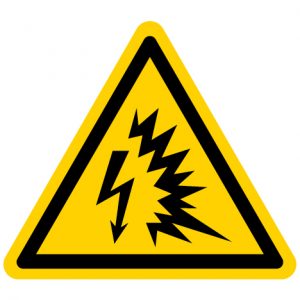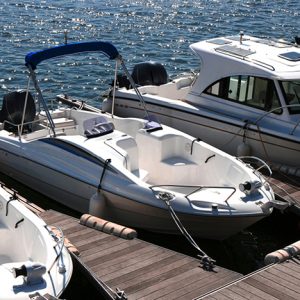By The Nexus Energy Team
Five Electrical Safety Tips to Keep You Connected to Safety

The Electrical Safety Foundation International (ESFI) established National Electrical Safety Month in 2014 to educate the American public about common risks and how to ensure electrical safety at home and work. This designation also offers our industry an annual opportunity to take stock of and reaffirm our commitment to the safety practices that protect those who engage with the systems, facilities and projects we design and support.
Nexus means connection, so we are particularly excited about this year’s Electrical Safety Month theme: Connected to Safety. To celebrate, our energy team shares the following tips to promote electrical safety in and out of the workplace.
1. Testing your AFCI and GFCI monthly
Invented in 1961 by Charles Dalziel, the humble GFCI has its 60th anniversary this year. As Industry members, we’re required to conduct and document monthly GFCI tests. But many who follow this practice professionally may not be as vigilant at home.
Similarly, testing arc-fault circuit interrupters (AFCI) monthly at home is a simple way to save lives. While the number of home fires and injuries continue to decrease annually, the cost of property damage and loss of life per fire are on the rise. Major culprits include arc-faults caused by deteriorating wiring and overloaded circuits. They ignite more than 35,000 home fires each year.
Tip: As homeowners, we should test both AFCIs and GFCIs monthly to ensure they are functioning well. ESFI shares the following resources for testing them at home.
2. Layering PPE

Arc-rated personal protective equipment (PPE) saves lives and prevents injuries, yet there are still misconceptions about PPE, in particular the layering of protective clothing.
Tip: When arc-rated PPE is required for electrical work, always choose an arc-rating higher than the equipment’s available arc-flash incident energy.
Here are two more important considerations:
- Underclothes and non-arc-rated shirts and pants: What should be worn with arc-rated PPE? Besides the outer layer of PPE, non-arc-rated underlayers of clothing are allowed only if they are made up of non-melting (natural) materials such as cotton, wool, silk, or leather. Where arc-rated PPE is required for a task, it is not permitted to wear non-arc-rated clothing as the outer layer–it must be the arc-rated PPE. High-visibility vests should be arc-rated (not just FR rated) if worn outermost.
- Layers: In the past, it was common to “add” up the arc-ratings on multiple layers to achieve higher arc-rated values. For instance, a 4 cal/cm2 shirt was worn with an 8 cal/cm2 coverall, with a loose fit between the garments. This enables higher arc ratings to be achieved with lower rated PPE. The arc rating on this combination was said to be 4+2 (air gap) +8=14 cal/cm2.
This custom layering and adding of values is no longer permitted by NFPA 70E. For one thing, “credit” for the 2 cal/cm2 air gap can no longer be taken or counted on. Second, history has demonstrated that the resulting arc rating of the combination of garments is not necessarily additive. While many times 4+8=12 cal/cm2 when two arc rated garments of these values are combined, experience showed that certain combinations produced MORE than an additive value (4+8=16 cal/cm2), while a smaller number of combinations produced LESS than an additive value (4+8=10 cal/cm2).
Today NFPA 70E requires that layers be tested as a system to provide increased rating when used together. A PPE manufacturer tests its shirts with other shirts, coveralls, and so forth, then determines exactly what models of garments produce a given arc-rating. Arc-rated clothing manufacturers routinely provide listings of layering combinations that have been tested. Quite often the lower-rated garment is better worn outside, so that it breaks open and ablates the heat from the incident energy, providing more protection to the higher arc-rated inner garment.
3. Updating Your Five-Year Plans
Companies should have in place arc-flash incident energy calculations and studies, along with arc-flash labeling, procedures, or both to safeguard personnel.
Tip: According to NFPA 70E, arc-flash incident energy studies should be reviewed and, if needed, updated every five years.
The condition, type, and responses of overcurrent devices must be considered when reviewing the hazard analysis, and, if there are major modifications or renovations, or if protective devices have been altered, the study should be updated, as well.
Nexus has a detailed, standardized approach to its five-year arc-flash study updates that determines an effective level of effort to both expedite the review and ensure the integrity of the results. Our one line verification, methods of verifying changes and evaluating protective devices, and interviews with site personnel often bring changes and additions to light. Contact the Nexus Energy team for more information.
4. Protecting your people — Electrical Safety Program (ESP)
Your company should have an Electrical Safety Program, or ESP, to protect its employees. NFPA states that “the employer shall implement and document an overall electrical safety program that directs activity appropriate to the risk associated with electrical hazards.” The ESP does not have to stand on its own, and, in fact, it should not. Wherever a company has an overall occupational health and safety management system, then the ESP should be integrated as part of it.
Tip: Too often a company’s ESP is lacking in one or more key areas. Be sure yours includes the major requirements outlined by NFPA 70E-2021:
The ESP must:
- Be customized to the site [110.5]
- Assess hazards & work practices [110.5 (H)]
- Selects PPE for the job [130 and Annex H]
- Require annual evaluation of work practices [110.6(A)(1)(f)]
- Require audits (various), creates, and keeps records [110.5(K)]
- Require employees to demonstrate task proficiency [110.6(A)(1)]
- Provide Electrical Safety Training to Employees [110.6]
- Offers methods for electrical incident investigation [110.5(J)]
There may be gaps in any good ESP related to specific site hazards, personnel issues, and related corporate standards. Technology, safety practices, and our understanding of the human elements of electrical safety keep improving. Thus, the ESP should be a living document.
Nexus can help identify gaps, opportunities for improvement, or errors in corporate ESP documents.
5. Preventing electric shock drowning

Finally, with summer weather approaching, many of us will be enjoying time on the water over our evenings, weekends, and time away from the office. When you were young you likely learned how to be safe in and around water. But you may not have learned how to identify and avoid the risk of electric shock drowning (ESD).
ESD occurs when faulty wiring sends an electrical current into the water, which passes through the body and causes paralysis, ultimately resulting in drowning or electrocution. ESD can occur anywhere there are humans and water, such as private pools and hot tubs, but most fatalities occur in electrified marinas and boat docks. The danger lies when there is an electrical fault, the grounding system is broken, or there is no ground fault protection to begin with.
Tip: Take the following steps if you find yourself in a potential ESD situation:
- If you are in the water and feel either a tingling or a shock, do not swim to the dock. Instead, stay upright, back out of the area the way you came in, and head for shore 100 yards sideways. As you go, call to others to let them know what is happening. Once on shore, seek medical attention.
- If you see someone in the water who may be experiencing signs of ESD, do everything you can to avoid entering the water. You will only put yourself into the same situation. Attempt to identify and turn off power to whatever is causing the electrical fault and call 911. Once power is off, you can reach for the victim or use a rope and life preserver to pull the victim from the water.
- If you are a boat owner, make sure to get your boat tested once a year to see if it is leaking electricity. Include GFCIs in your dock’s electric power and install GFCI outlets for required branch circuits on your boat. This protects against flaws in the devices plugged into them but offers no protection from the danger of a failing hard-wired appliance, such as a water heater or cooktop.
- Consider an ELCI (Equipment Leakage Circuit Interrupter) on your boat or in your ship to shore cord. ELCI protection combined with GFCI branch protection will reduce the risk to those on the boat, the dock and in the surrounding water.
Managing electrical safety can be complex and time-consuming, but it is vital to the success of any organization. Nexus keeps abreast of advancements in electrical safety and can help businesses manage this process. Contact our energy team today for more information on how we can support your energy safety goals.





